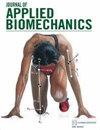重复深跳时的力量-时间特征以及压缩服的影响。
IF 1.1
4区 医学
Q4 ENGINEERING, BIOMEDICAL
引用次数: 0
摘要
目前还没有任何研究报告了常用于研究运动诱发肌肉损伤的重复深度跳(DJ)方案的地面反作用力(GRF)曲线。此外,虽然压缩衣(CG)可能会加速运动诱发的肌肉损伤的恢复,但对重复运动效果的影响尚不清楚。因此,我们研究了 2 次重复阵发性 DJ 损伤的 GRF 曲线,以及穿戴 CG 对恢复的影响。在 20 × 20 米短跑和 10 × 10 0.6 米 DJ 之后,非阻力训练男性随机接受 CG(n = 9)或安慰剂(n = 8)72 小时恢复训练。采用 3 向(一组 × 两组 × 一组)设计,用方差分析和统计参数图评估 GRF 的变化。不同组间的跳跃高度、反应力量、峰值和平均推进力均有所下降(P < .001)。垂直刚度、接触时间、零速力和推进持续时间则有所增加(P < .05)。根据统计参数图,制动(占运动的 17%-25%)和推进力(58%-81%)下降(P < .05)。在重复运动中,峰值推进力和持续时间增加了(P < .05),而平均推进力(P < .05)和从 59% 到 73% 的 GRF 则下降了(P < .001)。在偏心阶段未发生变化或未受到 CG 影响的情况下,重复阵列 DJ 在推进 GRF 方面存在差异。本文章由计算机程序翻译,如有差异,请以英文原文为准。
Force-Time Characteristics of Repeated Bouts of Depth Jumps and the Effects of Compression Garments.
No studies have reported ground reaction force (GRF) profiles of the repeated depth jump (DJ) protocols commonly used to study exercise-induced muscle damage. Furthermore, while compression garments (CG) may accelerate recovery from exercise-induced muscle damage, any effects on the repeated bout effect are unknown. Therefore, we investigated the GRF profiles of 2 repeated bouts of damage-inducing DJs and the effects of wearing CG for recovery. Nonresistance-trained males randomly received CG (n = 9) or placebo (n = 8) for 72 hours recovery, following 20 × 20 m sprints and 10 × 10 DJs from 0.6 m. Exercise was repeated after 14 days. Using a 3-way (set × bout × group) design, changes in GRF were assessed with analysis of variance and statistical parametric mapping. Jump height, reactive strength, peak, and mean propulsive forces declined between sets (P < .001). Vertical stiffness, contact time, force at zero velocity, and propulsive duration increased (P < .05). According to statistical parametric mapping, braking (17%-25% of the movement) and propulsive forces (58%-81%) declined (P < .05). During the repeated bout, peak propulsive force and duration increased (P < .05), while mean propulsive force (P < .05) and GRF from 59% to 73% declined (P < .001). A repeated bout of DJs differed in propulsive GRF, without changes to the eccentric phase, or effects from CG.
求助全文
通过发布文献求助,成功后即可免费获取论文全文。
去求助
来源期刊

Journal of Applied Biomechanics
医学-工程:生物医学
CiteScore
2.00
自引率
0.00%
发文量
47
审稿时长
6-12 weeks
期刊介绍:
The mission of the Journal of Applied Biomechanics (JAB) is to disseminate the highest quality peer-reviewed studies that utilize biomechanical strategies to advance the study of human movement. Areas of interest include clinical biomechanics, gait and posture mechanics, musculoskeletal and neuromuscular biomechanics, sport mechanics, and biomechanical modeling. Studies of sport performance that explicitly generalize to broader activities, contribute substantially to fundamental understanding of human motion, or are in a sport that enjoys wide participation, are welcome. Also within the scope of JAB are studies using biomechanical strategies to investigate the structure, control, function, and state (health and disease) of animals.
 求助内容:
求助内容: 应助结果提醒方式:
应助结果提醒方式:


